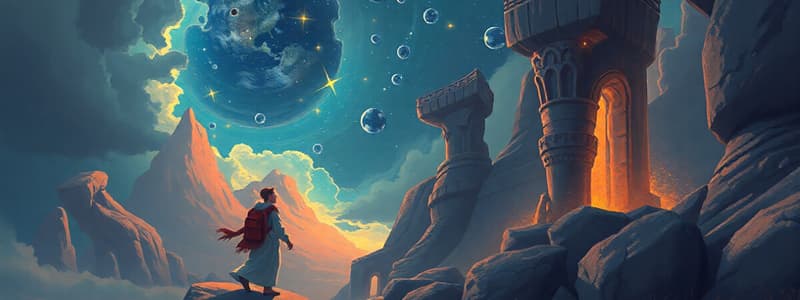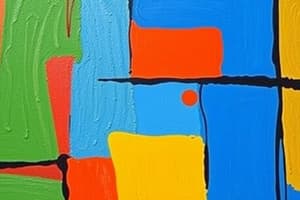Podcast
Questions and Answers
What defines ephemeral arts?
What defines ephemeral arts?
- They are created using only digital mediums.
- They are permanent and can be viewed indefinitely.
- They are only performed in traditional theater settings.
- They must be replayed or have a limited viewing period. (correct)
Which materials can decorative objects be made from?
Which materials can decorative objects be made from?
- Natural stones and fabrics only.
- Only ceramics and glass.
- Ceramics, metal, wood, and other materials. (correct)
- Synthetic materials exclusively.
What is a primary function of architecture?
What is a primary function of architecture?
- To create temporary art installations.
- To be exclusively functional without aesthetic value.
- To serve as a decorative object.
- To provide enclosures for human activity. (correct)
Which of the following is NOT included in the common understanding of an art object's caption?
Which of the following is NOT included in the common understanding of an art object's caption?
What medium was used for Leonardo da Vinci's Mona Lisa?
What medium was used for Leonardo da Vinci's Mona Lisa?
Which of the following is NOT considered a physical characteristic of an art object?
Which of the following is NOT considered a physical characteristic of an art object?
What aspect of art history focuses on what is being communicated in an art object?
What aspect of art history focuses on what is being communicated in an art object?
Which question is essential to discovering the context of an art object?
Which question is essential to discovering the context of an art object?
What does the term 'context' refer to in the study of art history?
What does the term 'context' refer to in the study of art history?
Which of the following is NOT a visual characteristic of art?
Which of the following is NOT a visual characteristic of art?
The study of what an art object is made from falls under which category of art history?
The study of what an art object is made from falls under which category of art history?
Which of the following best defines the content of an art object?
Which of the following best defines the content of an art object?
To fully understand an art piece, it is essential to explore which of the following questions?
To fully understand an art piece, it is essential to explore which of the following questions?
What time period does ARTH 100 cover?
What time period does ARTH 100 cover?
What defines a painting?
What defines a painting?
Which of the following is not a type of sculpture?
Which of the following is not a type of sculpture?
What material can sculpture be commonly made from?
What material can sculpture be commonly made from?
How are prints made in graphic arts?
How are prints made in graphic arts?
What is the primary characteristic of relief sculpture?
What is the primary characteristic of relief sculpture?
Which medium involves creating optical images on light-sensitive surfaces?
Which medium involves creating optical images on light-sensitive surfaces?
What is an example of a two-dimensional art object?
What is an example of a two-dimensional art object?
What is one aspect of art history that is studied?
What is one aspect of art history that is studied?
Which of the following correctly defines 'content' in the context of art history?
Which of the following correctly defines 'content' in the context of art history?
Which term refers to the historical circumstances of an artwork's production?
Which term refers to the historical circumstances of an artwork's production?
What is emphasized as crucial for success in ARTH 100?
What is emphasized as crucial for success in ARTH 100?
In the study of art history, which element is NOT typically examined as part of an art object's form?
In the study of art history, which element is NOT typically examined as part of an art object's form?
Which aspect of an art object involves its physical and visual characteristics?
Which aspect of an art object involves its physical and visual characteristics?
What does the study of context in art history primarily focus on?
What does the study of context in art history primarily focus on?
What year approximately does the Woman from Willendorf date back to?
What year approximately does the Woman from Willendorf date back to?
Which of the following correctly describes the original function of the Woman from Willendorf?
Which of the following correctly describes the original function of the Woman from Willendorf?
What is the primary visual medium of Alice Neel's Self Portrait?
What is the primary visual medium of Alice Neel's Self Portrait?
Flashcards are hidden until you start studying
Study Notes
Art History: Key Concepts
- Art History studies the form, content, and context of art objects.
- Form encompasses the physical and visual characteristics of an artwork, including its medium, material, dimensions, and visual elements like line, shape, form, color, texture, space, and composition.
- Content refers to what the art object communicates, including its subject matter (what it depicts) and its theme (the underlying message or idea).
- Context refers to the historical circumstances in which the art object was created and viewed, including the time, place, political, social, religious, and intellectual cultures of the period.
- To understand the context of an artwork, consider questions like:
- Where was it made?
- When was it made?
- What political, religious, and intellectual contexts were relevant at the time?
- Who was the artist?
- Who was the patron (the person or entity that commissioned the work)?
- ARTH 100 covers art history from prehistory (30,000 BCE) to the present (with a focus on the 19th century).
- Medium refers to the type of art object, often specifying the material used.
- Painting is a two-dimensional art form created with pigments, including wall paintings, illuminations, paintings on wood or canvas, and hanging scroll paintings.
- Sculpture is a three-dimensional art form, typically made of materials like wood, stone, bronze, ivory, or marble. It can be carved, modeled, or cast. Sculpture can be free-standing (in the round), surrounded by space, or in relief, projecting from a background surface.
- Graphic Arts encompass drawings, made by hand, and prints, made with machines and produced in multiple copies. Both are typically created on paper.
- Photography involves creating optical images on light-sensitive surfaces, traditionally using a camera.
- Decorative Objects can be made of ceramics, metal, wood, and other materials.
- Architecture creates enclosures for human activities and habitation. It is characterized by its spatial qualities, functionality, and close relationship with technology and materials.
- Ephemeral Arts include events like processions, ceremonies, ritual dances, performance art, earthworks, cinema, video art, and some forms of digital art. These artworks are often temporary or in constant change and require replaying to be experienced.
- Art object captions typically include the artist's name, title of the work, year made, medium, material, and dimensions.
- To successfully complete ARTH 100, it is critical to take thorough notes in class.
Learning Objectives:
- Understand Key Concepts: Define form, content, and context in relation to art history.
- Recognize Different Artistic Media: Identify the characteristics of various art forms like painting, sculpture, graphic arts, photography, decorative objects, architecture, and ephemeral arts.
- Analyze Art Object Captions: Interpret the information provided in art object captions.
- Develop Active Note-Taking Skills: Master effective note-taking techniques for this course.
Studying That Suits You
Use AI to generate personalized quizzes and flashcards to suit your learning preferences.




